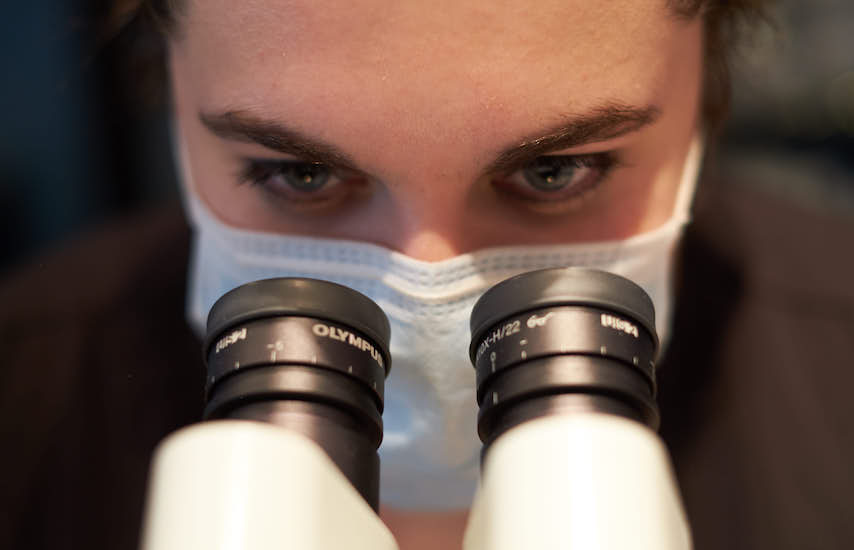Male Fertility Testing

Given that sperm contribute half the genetics of a growing embryo and future child, it shouldn’t come as a surprise that male factors should be tested for in anyone trying to get pregnant.
In fact, Dr. Edward Ditkoff, a reproductive endocrinologist at CNY Fertility, typically tells couples that “30% of infertility is related to male factor alone; 30% of infertility is related to female factor alone; 10% of the time we don’t know what’s causing the infertility; 30% of the time there’s a combination of male and female factors. So, up to 50% of fertility can be related to male factors.”
Performing thorough male fertility testing prior to treatment may take a little extra time and money upfront, but it can help you and your fertility specialist determine the right fertility treatment for you and save you thousands of dollars in the long run. That’s because treatments like IUIs are only advisable for those with relatively healthy and motile sperm, while treatments like IVF can successfully treat the most significant sperm health issues.
The remainder of this article will explore initial and follow-up male fertility tests, the limitations of such testing, and discuss potential next steps.
Basic Male Fertility Testing – The Semen Analysis
A semen analysis is a very simple male fertility test that usually requires only one sample, which can be obtained through ejaculation into a sterile cup.
A semen analysis is a necessary first step in assessing male fertility and the only test that is initially required for a male pursuing fertility treatment at most fertility clinics, including CNY.
A semen analysis looks at a man’s:
- Sperm count or concentration of sperm per ml of semen
- Total volume
- PH level
- Motility (how well the sperm move and with forward progression)
- Morphology (the shape and appearance of the sperm)
- Viscosity (the fluidity of the semen)
- The presence of immature sperm
- The presence or absence of blood cells
Additional Male Fertility Testing – If Abnormal Semen Analysis
If your semen tests in the abnormal range for certain parameters, or it appears that sperm production is an issue, it is likely we will recommend additional testing.
That starts with a repeat of the semen analysis to ensure it was not simply a bad collection. If that too comes back with issues additional testing may be requested.
Male Fertility Hormone Testing
Hormones play a major role in both male and female reproductive health. For males, three main hormones must remain balanced for optimal fertility — testosterone, luteinizing hormone (LH), and follicle-stimulating hormone (FSH). Too much or too little of any of these hormones can affect sperm production and sperm health. A simple blood test is all that is required to test various levels. But even if your levels come back normal, that doesn’t necessarily guarantee there isn’t a problem.
- Testosterone: Low testosterone levels can alter the production of sperm due to its central role in sperm production. Testosterone levels range from 300 to 1,111 nanograms per deciliter. Levels outside this range can indicate a problem.
- Follicle-Stimulating Hormone (FSH): a sex hormone that in males helps maintain adequate sperm production. Normal FSH levels should be in the 5 to 10 mlU/mL range.
- Luteinizing Hormone (LH): a sex hormone that stimulates the production of testosterone. A range of 2 to 18 mIU/mL is considered normal.
- Prolactin: Used to help determine problems related to the pituitary gland and testosterone levels
- Thyroid Stimulating Hormone (TSH): Low thyroid levels can cause poor semen quality, testicular function, and disturb sex drive.
The good news is that your hormones are affected by a number of things, including lifestyle factors and exposure to hormonal disruptors. By testing and identifying where there’s an imbalance, we’ll likely be able to take action to correct it.
Genetic Screening for Male Fertility
In men, genetic abnormalities can cause infertility by affecting sperm production or how the sperm moves from the testicles to semen. Genetic testing helps you understand your risk for further failed cycles or early pregnancy loss and can help identify where the problem is occurring. It also helps determine if you should stick with your current treatment plan, progress to the next stage, or perhaps move directly to IVF with ICSI.
The three most common genetic tests related to male infertility screen for:
- Cystic Fibrosis Transmembrane Conductance Regulator (CFTR) Gene Mutations: Men with congenital bilateral absence of the vas deferens (CBAVD), which is when both vas deferens do not develop, require a test to determine if they are a carrier for the cystic fibrosis gene. This does NOT mean that they have cystic fibrosis, but men who have CBAVD can be carriers for an abnormal copy of this gene. A physician can determine whether or not you have vas deferens during a physical exam. If CBAVD is confirmed, both partners should have genetic testing and counseling in case they are carriers of cystic fibrosis (CF), which can be passed on to children.
- Karyotype: Also known as chromosome analysis, this test analyzes the number and set-up of all chromosomes to see if there are any extra or missing chromosomes. Extra chromosomes can cause problems with sperm production. One example is Klinefelter Syndrome (KS), in which a man has an extra sex chromosome: XXY instead of XY.
- Y-Chromosome Microdeletions (YCMD): If you have Y-chromosome deletions, they can cause problems with how your sperm form. There is a genetic test that can be done to determine whether your Y chromosome contains all the critical genetic elements necessary to make sperm. This is important because there are some genetic mutations of the Y chromosome that are not compatible with producing sperm.
If your sperm analysis shows fewer than five million sperm per mL, we will likely recommend karyotyping and Y-chromosome analysis.
Oligospermia & Azoospermia Testing
Tests for Sperm Production Issues: If a man is diagnosed with oligospermia (low sperm count) or azoospermia (complete absence of sperm), there are tests that can help further identify the cause of the production issue. If little or no sperm is showing up in a man’s semen, the problem could be the result of a blockage.
- X-ray and ultrasound tests can help identify if there is a blockage, as well as where it is located within the reproductive tract.
- A vasography can determine if the vas deferens is blocked or leaking sperm. If the problem isn’t a blockage, a testicular biopsy can help understand how well sperm are being produced. This involves removing a small piece of tissue from the tubules in the testes, which is then evaluated.
- Retrograde Semen Analysis is another recommended test for men with low sperm count. In some men, semen passes into the bladder instead of out through the urethra, causing sperm to appear in the urine after sex. This is known as retrograde ejaculation, and it occurs when the nerves and muscles that control ejaculation are damaged or removed or if the prostate is enlarged. Most men with retrograde ejaculation have a previously diagnosed medical condition or have had prostate or testicular surgery.
Tests for Sperm Motility Issues
There are several tests that evaluate sperm penetration, such as the Acrosome Reaction Test, Sperm Penetration Assay, and the Hemizona Assay Test. The Hemizona Assay Test uses a non-usable human egg that is cut in half to observe whether sperm can penetrate the outer layer. However, we almost never recommend it. Once egg penetration has been identified as the problem, the recommended solution is likely to be IVF with ICSI, which circumvents any sperm issues.
Varicocele Testing – Testicular/Scrotum Ultrasound
A varicocele is an enlargement of the veins within the scrotum. Varicoceles are similar to varicose veins you might see in your legs and are a common cause of low sperm production and decreased sperm quality, which can cause infertility. Varicoceles often produce no other signs or symptoms. To diagnose, an ultrasound of the scrotum may be used to identify enlarged veins surrounding the testes.
What Male Fertility Testing Can Tell Us & What It Can’t
The majority of male fertility testing aims to determine (1) whether you have sperm and (2) whether they can reach an egg. Answers to these questions are critical but remember, male fertility is not static, and there are lots you can do to improve it.
Additionally, there are times when a semen analysis alone doesn’t give a clear or complete answer. Infertility is a highly complex, multifaceted problem. For heterosexual couples, it’s important to look at female testing as well. While additional testing is available, it’s not always recommended or necessary because there are treatment options, such as IVF with ICSI, that offer a viable solution.
Testing can help you and your provider decide the best course of treatment so that you don’t waste time and money waiting or pursuing other treatments that may not be effective based on your individual situation.
Remember, if you’ve been trying to get pregnant for 6 months to a year with no pregnancies or multiple miscarriages, it’s probably time to schedule a consultation with a specialist.




